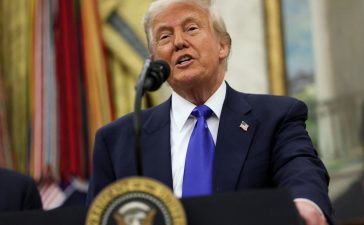Picture this: debate over the debt ceiling is in the 11th hour and the US is almost reaching default.
Members of Congress are hurrying around the US Capitol, holding press conferences and getting into arguments. As Republicans and Democrats rail against each other, an unlikely savior appears. A platinum coin is minted as a machine stamps it with “One Trillion Dollars”, which is then given to the US central bank.
With this single trillion dollar coin, the US federal government has the money to continue paying for services like social security and Medicare, avoiding catastrophic default.
At least, that’s what some people believe could be the solution to the current debt-ceiling standoff. If the idea sounds ridiculous, advocates for the coin argue that default over the debt ceiling – which would cause huge economic damage to the US – is even more ludicrous.
In early January, the treasury secretary, Janet Yellen, told Congress that the country hit its $31.4tn debt ceiling and the treasury would need to pursue “extraordinary measures” to ensure it does not default on payments.
The debt ceiling is a cap on the amount of money the federal government can borrow to pay for spending already allocated by Congress. In other words, Congress has already directed Biden to spend the money, but has not allowed him access to all the money he needs to carry out the spending.
Democrats need Republican buy-in to raise the debt ceiling, but Republicans are refusing to give in unless Democrats agree to spending cuts.
If it seems like deja vu, it is: fights over the debt ceiling have become more common over the last decade. The worst was in 2011, when Republicans used the debt ceiling to negotiate $1tn in spending cuts from then-president Barack Obama. During the whole standoff, S&P downgraded the country’s credit score, making it more expensive for the US to borrow money.
This time, the White House said it will not negotiate over the debt ceiling. The Biden administration says default will happen if Republicans refuse to raise the debt ceiling by June at the earliest. The standoff could get ugly, and it holds hefty consequences the longer it is drawn out, but scholars say the administration has some options to avoid the worst-case scenario – including the trillion-dollar coin.
Advocates for the strategy say the legality of the coin lies in a law passed in the 90s that allows the US Mint to mint platinum coins of any denomination.
To avert default, the Mint would strike the $1tn coin, give it to the Federal Reserve and cha-ching, the government would have more money to pay off its debt. When the debt ceiling is raised, the coin would go back to the Mint to be melted.
If the idea of a trillion-dollar coin sounds like something born out of the internet, it kind of was: it was first floated in the comment section of a blog in 2010 by a lawyer from Georgia named Carlos Mucha.
The blog was that of Warren Mosler, a prominent advocate for Modern Monetary Theory, known as MMT, which has been promoted by progressive Democrats such as Alexandria Ocasio-Cortez in recent years. Put very simply, the theory maintains that a government that makes its own currency cannot run out of money, thus it does not need to act as if it has budgetary restraints, like households have.
The trillion-dollar coin encapsulates this idea. It would be a very clear display of how the US government can make its own money, by actually minting it.
“A coin is the kind of thing that you can talk about with your kids around the dinner table,” said Rohan Grey, a law professor at Willamette University and a proponent of MMT and minting the trillion-dollar coin. “[It] is a huge symbol of the public monetary power. It’s a very concise and concentrated symbol.
“Every time we talk about the government budget – tax, borrow, tax, borrow – we don’t even talk about creating money as the underlying power the whole framework is built around.”
While advocates of minting the coin – including former US Mint director Phillip Diehl, who helped create the platinum coin law – vouch for its legality and the process it would go through, critics question whether the Fed would accept the coin and if it is as legally sound as its supporters say.
Investors could also see the minting of such a coin as a good reason to doubt the US’s ability to pay off its debt, with the country having to turn to such an outlandish measure, opponents contend.
Treasury secretary Yellen dismissed the idea herself multiple times. In October 2021, she said, “I don’t think we should consider it seriously. It’s really a gimmick.” Again in January, she turned down the idea, telling the Wall Street Journal the Fed might not even accept such a coin.
Besides rejecting the coin idea, the administration has been mum on any alternatives they see to bypassing the debt ceiling, even though they said they refused to negotiate with Republicans.
Some scholars argue for another alternative if it comes to it: ignoring the debt ceiling, which would see the treasury continue to sell bonds to pay off the debt.
“My view is that you eventually reach the point where there’s nothing you can do that’s legal,” said Michael Dorf, a law professor at Cornell University. “When none of your options are legal, you should take the option that is least illegal.”
Dorf, along with frequent collaborator Neil Buchanan, a University of Florida law professor, has argued that the trillion-dollar coin is probably illegal given that the platinum coin law is meant for commemorative coins.
“Nobody thought when they passed the statute that it would be used for this purpose,” he said. “It’s just an inferior option to issuing debt in the normal course as though there were no debt ceiling.”
While ignoring the debt ceiling would mean the executive branch is skirting a law passed by Congress, Dorf and Buchanan reason it is better than any actions that are more like exercises of legislative power, such as raising taxes or deciding where to cut spending.
Some scholars assert that a clause in the 14th amendment says that the country’s debt “shall not be questioned”, essentially making the debt ceiling unconstitutional. The so-called “public debt clause” could give constitutional protection to Biden if he ignores the ceiling, should the question be ever brought to court.
Grey and other advocates for the coin acknowledge that ignoring the debt ceiling is one option, but they see minting the coin as something that is within an existing law and that makes transparent the government’s ability to create money.
“Something as big and as disruptive as the coin, that’s the sort of scale at which we need to break people out of their way of thinking,” Grey said.
Amid debate over how the administration should respond to this impending debt ceiling crisis – mint the coin, ignore the debt ceiling, etc – scholars agree that Democrats should have gotten rid of it or lifted it higher when they had both majorities in Congress. While the idea was floating around in December, it did not receive the momentum it needed to gain traction.
“What we’re dealing with now is the same problem we had [in 2011],” Grey said. Democrats “have got us to this point where they had the chance to fix the problem, but [they] did not make it a priority to get rid of the debt ceiling during the legislative session.”







